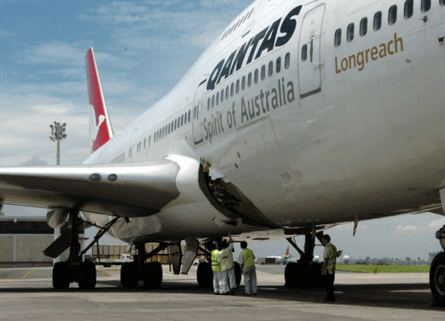An exploding oxygen cylinder in a Qantas Airways Boeing 747-400 bellyhold became a projectile that blasted up through the galley floor, hit a main door so hard it distorted it, then impacted the galley ceiling before falling back through the floor and dropping out of a hole the explosion had created in the aircraft's fuselage.
This detail has emerged from the Australian Transport Safety Bureau preliminary factual report on the 25 July incident, which has also revealed that the cylinder severed some of the co-pilot's control runs. "Both right-side first officer's aileron control cables routed along the right side of the fuselage above the passenger oxygen cylinders had been fractured during the rupture event," it says.
The 747 departed Hong Kong for Melbourne, Australia and it was at 29,000ft (8,850m) when the explosion took place, causing cabin decompression. The report notes the oxygen masks deployed and the flightcrew began an emergency descent to 10,000ft before diverting to Manila airport in the Philippines.
 |
|---|
The report describes the visible damage to the hull as "an inverted T-shaped rupture in the lower right side of the fuselage immediately beneath the wing leading edge-to-fuselage transition fairing that had been lost during the event". It says the rupture was about 2m along the length of the aircraft and 1.5m vertically.
The report continues: "After clearing the baggage and cargo from the forward aircraft hold it was evident that one passenger oxygen cylinder, number 4 from a bank of seven along the right side of the cargo hold, had sustained a sudden failure and forceful discharge of the contents into the aircraft hold, rupturing the fuselage...the cylinder had been propelled upward by the force of the discharge, puncturing the cabin floor and entering the cabin adjacent to the second main door.
The cylinder then "impacted the door frame, door handle and overhead panelling before falling through the cabin floor and exiting the aircraft through the ruptured fuselage".
The investigator explains that "because the failed cylinder was not recovered, the ATSB is currently working with the aircraft manufacturer, other aircraft operators and the oxygen cylinder manufacturer to obtain samples of cylinders from the same manufacturing batch as the failed item".
Meanwhile, work has started on repairing the 747, with the aircraft due to return to service in November, says chief executive Geoff Dixon. He estimates the repair cost at "less than A$10 million [$8.7 million]".
Source: Flight International























